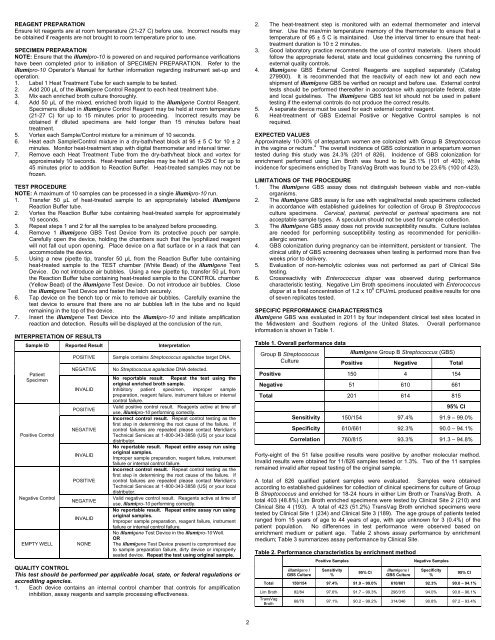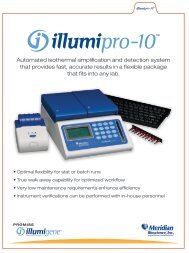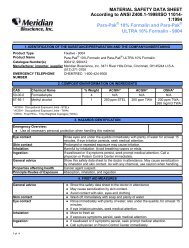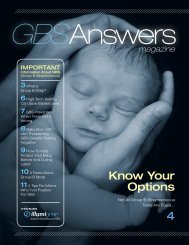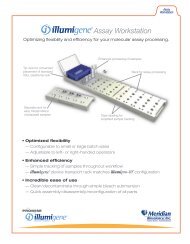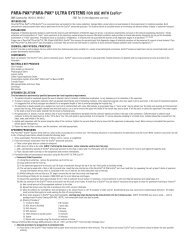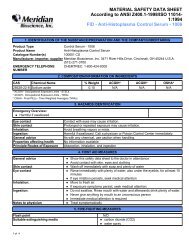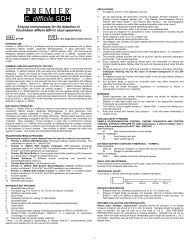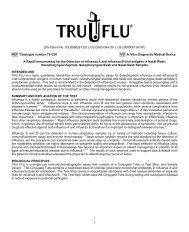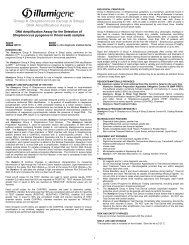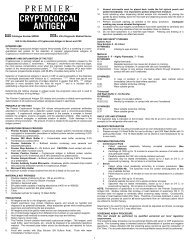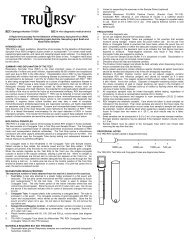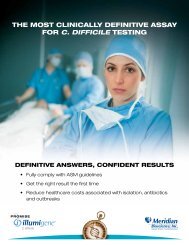DNA Amplification Assay for the Detection of Group B Streptococcus ...
DNA Amplification Assay for the Detection of Group B Streptococcus ...
DNA Amplification Assay for the Detection of Group B Streptococcus ...
You also want an ePaper? Increase the reach of your titles
YUMPU automatically turns print PDFs into web optimized ePapers that Google loves.
REAGENT PREPARATION<br />
Ensure kit reagents are at room temperature (21-27 C) be<strong>for</strong>e use. Incorrect results may<br />
be obtained if reagents are not brought to room temperature prior to use.<br />
SPECIMEN PREPARATION<br />
NOTE: Ensure that <strong>the</strong> illumipro-10 is powered on and required per<strong>for</strong>mance verifications<br />
have been completed prior to initiation <strong>of</strong> SPECIMEN PREPARATION. Refer to <strong>the</strong><br />
illumipro-10 Operator’s Manual <strong>for</strong> fur<strong>the</strong>r in<strong>for</strong>mation regarding instrument set-up and<br />
operation.<br />
1. Label 1 Heat Treatment Tube <strong>for</strong> each sample to be tested.<br />
2. Add 200 µL <strong>of</strong> <strong>the</strong> illumigene Control Reagent to each heat treatment tube.<br />
3. Mix each enriched broth culture thoroughly.<br />
4. Add 50 µL <strong>of</strong> <strong>the</strong> mixed, enriched broth liquid to <strong>the</strong> illumigene Control Reagent.<br />
Specimens diluted in illumigene Control Reagent may be held at room temperature<br />
(21-27 C) <strong>for</strong> up to 15 minutes prior to proceeding. Incorrect results may be<br />
obtained if diluted specimens are held longer than 15 minutes be<strong>for</strong>e heat<br />
treatment.<br />
5. Vortex each Sample/Control mixture <strong>for</strong> a minimum <strong>of</strong> 10 seconds.<br />
6. Heat each Sample/Control mixture in a dry-bath/heat block at 95 ± 5 C <strong>for</strong> 10 ± 2<br />
minutes. Monitor heat-treatment step with digital <strong>the</strong>rmometer and interval timer.<br />
7. Remove each Heat Treatment Tube from <strong>the</strong> dry-bath/heat block and vortex <strong>for</strong><br />
approximately 10 seconds. Heat-treated samples may be held at 19-29 C <strong>for</strong> up to<br />
45 minutes prior to addition to Reaction Buffer. Heat-treated samples may not be<br />
frozen.<br />
TEST PROCEDURE<br />
NOTE: A maximum <strong>of</strong> 10 samples can be processed in a single illumipro-10 run.<br />
1. Transfer 50 µL <strong>of</strong> heat-treated sample to an appropriately labeled illumigene<br />
Reaction Buffer tube.<br />
2. Vortex <strong>the</strong> Reaction Buffer tube containing heat-treated sample <strong>for</strong> approximately<br />
10 seconds.<br />
3. Repeat steps 1 and 2 <strong>for</strong> all <strong>the</strong> samples to be analyzed be<strong>for</strong>e proceeding.<br />
4. Remove 1 illumigene GBS Test Device from its protective pouch per sample.<br />
Carefully open <strong>the</strong> device, holding <strong>the</strong> chambers such that <strong>the</strong> lyophilized reagent<br />
will not fall out upon opening. Place device on a flat surface or in a rack that can<br />
accommodate <strong>the</strong> device.<br />
5. Using a new pipette tip, transfer 50 µL from <strong>the</strong> Reaction Buffer tube containing<br />
heat-treated sample to <strong>the</strong> TEST chamber (White Bead) <strong>of</strong> <strong>the</strong> illumigene Test<br />
Device. Do not introduce air bubbles. Using a new pipette tip, transfer 50 µL from<br />
<strong>the</strong> Reaction Buffer tube containing heat-treated sample to <strong>the</strong> CONTROL chamber<br />
(Yellow Bead) <strong>of</strong> <strong>the</strong> illumigene Test Device. Do not introduce air bubbles. Close<br />
<strong>the</strong> illumigene Test Device and fasten <strong>the</strong> latch securely.<br />
6. Tap device on <strong>the</strong> bench top or mix to remove air bubbles. Carefully examine <strong>the</strong><br />
test device to ensure that <strong>the</strong>re are no air bubbles left in <strong>the</strong> tube and no liquid<br />
remaining in <strong>the</strong> top <strong>of</strong> <strong>the</strong> device.<br />
7. Insert <strong>the</strong> illumigene Test Device into <strong>the</strong> illumipro-10 and initiate amplification<br />
reaction and detection. Results will be displayed at <strong>the</strong> conclusion <strong>of</strong> <strong>the</strong> run.<br />
INTERPRETATION OF RESULTS<br />
Sample ID Reported Result Interpretation<br />
Patient<br />
Specimen<br />
Positive Control<br />
Negative Control<br />
EMPTY WELL<br />
POSITIVE<br />
NEGATIVE<br />
INVALID<br />
POSITIVE<br />
NEGATIVE<br />
INVALID<br />
POSITIVE<br />
NEGATIVE<br />
INVALID<br />
NONE<br />
Sample contains <strong>Streptococcus</strong> agalactiae target <strong>DNA</strong>.<br />
No <strong>Streptococcus</strong> agalactiae <strong>DNA</strong> detected.<br />
No reportable result. Repeat <strong>the</strong> test using <strong>the</strong><br />
original enriched broth sample.<br />
Inhibitory patient specimen, improper sample<br />
preparation, reagent failure, instrument failure or internal<br />
control failure.<br />
Valid positive control result. Reagents active at time <strong>of</strong><br />
use, illumipro-10 per<strong>for</strong>ming correctly.<br />
Incorrect control result. Repeat control testing as <strong>the</strong><br />
first step in determining <strong>the</strong> root cause <strong>of</strong> <strong>the</strong> failure. If<br />
control failures are repeated please contact Meridian’s<br />
Technical Services at 1-800-343-3858 (US) or your local<br />
distributor.<br />
No reportable result. Repeat entire assay run using<br />
original samples.<br />
Improper sample preparation, reagent failure, instrument<br />
failure or internal control failure.<br />
Incorrect control result. Repeat control testing as <strong>the</strong><br />
first step in determining <strong>the</strong> root cause <strong>of</strong> <strong>the</strong> failure. If<br />
control failures are repeated please contact Meridian’s<br />
Technical Services at 1-800-343-3858 (US) or your local<br />
distributor.<br />
Valid negative control result. Reagents active at time <strong>of</strong><br />
use, illumipro-10 per<strong>for</strong>ming correctly.<br />
No reportable result. Repeat entire assay run using<br />
original samples.<br />
Improper sample preparation, reagent failure, instrument<br />
failure or internal control failure.<br />
No illumigene Test Device in <strong>the</strong> illumipro-10 Well.<br />
OR<br />
The illumigene Test Device present is compromised due<br />
to sample preparation failure, dirty device or improperly<br />
seated device. Repeat <strong>the</strong> test using original sample.<br />
QUALITY CONTROL<br />
This test should be per<strong>for</strong>med per applicable local, state, or federal regulations or<br />
accrediting agencies.<br />
1. Each device contains an internal control chamber that controls <strong>for</strong> amplification<br />
inhibition, assay reagents and sample processing effectiveness.<br />
2. The heat-treatment step is monitored with an external <strong>the</strong>rmometer and interval<br />
timer. Use <strong>the</strong> max/min temperature memory <strong>of</strong> <strong>the</strong> <strong>the</strong>rmometer to ensure that a<br />
temperature <strong>of</strong> 95 ± 5 C is maintained. Use <strong>the</strong> interval timer to ensure that heattreatment<br />
duration is 10 ± 2 minutes.<br />
3. Good laboratory practice recommends <strong>the</strong> use <strong>of</strong> control materials. Users should<br />
follow <strong>the</strong> appropriate federal, state and local guidelines concerning <strong>the</strong> running <strong>of</strong><br />
external quality controls.<br />
4. illumigene GBS External Control Reagents are supplied separately (Catalog<br />
279900). It is recommended that <strong>the</strong> reactivity <strong>of</strong> each new lot and each new<br />
shipment <strong>of</strong> illumigene GBS be verified on receipt and be<strong>for</strong>e use. External control<br />
tests should be per<strong>for</strong>med <strong>the</strong>reafter in accordance with appropriate federal, state<br />
and local guidelines. The illumigene GBS test kit should not be used in patient<br />
testing if <strong>the</strong> external controls do not produce <strong>the</strong> correct results.<br />
5. A separate device must be used <strong>for</strong> each external control reagent.<br />
6. Heat-treatment <strong>of</strong> GBS External Positive or Negative Control samples is not<br />
required.<br />
EXPECTED VALUES<br />
Approximately 10-30% <strong>of</strong> antepartum women are colonized with <strong>Group</strong> B <strong>Streptococcus</strong><br />
in <strong>the</strong> vagina or rectum. 4 The overall incidence <strong>of</strong> GBS colonization in antepartum women<br />
tested during this study was 24.3% (201 <strong>of</strong> 826). Incidence <strong>of</strong> GBS colonization <strong>for</strong><br />
enrichment per<strong>for</strong>med using Lim Broth was found to be 25.1% (101 <strong>of</strong> 403); while<br />
incidence <strong>for</strong> specimens enriched by TransVag Broth was found to be 23.6% (100 <strong>of</strong> 423).<br />
LIMITATIONS OF THE PROCEDURE<br />
1. The illumigene GBS assay does not distinguish between viable and non-viable<br />
organisms.<br />
2. The illumigene GBS assay is <strong>for</strong> use with vaginal/rectal swab specimens collected<br />
in accordance with established guidelines <strong>for</strong> collection <strong>of</strong> <strong>Group</strong> B <strong>Streptococcus</strong><br />
culture specimens. Cervical, perianal, perirectal or perineal specimens are not<br />
acceptable sample types. A speculum should not be used <strong>for</strong> sample collection.<br />
3. The illumigene GBS assay does not provide susceptibility results. Culture isolates<br />
are needed <strong>for</strong> per<strong>for</strong>ming susceptibility testing as recommended <strong>for</strong> penicillinallergic<br />
women.<br />
4. GBS colonization during pregnancy can be intermittent, persistent or transient. The<br />
clinical utility <strong>of</strong> GBS screening decreases when testing is per<strong>for</strong>med more than five<br />
weeks prior to delivery.<br />
5. Evaluation <strong>of</strong> non-hemolytic colonies was not per<strong>for</strong>med as part <strong>of</strong> Clinical Site<br />
testing.<br />
6. Crossreactivity with Enterococcus dispar was observed during per<strong>for</strong>mance<br />
characteristic testing. Negative Lim Broth specimens inoculated with Enterococcus<br />
dispar at a final concentration <strong>of</strong> 1.2 x 10 8 CFU/mL produced positive results <strong>for</strong> one<br />
<strong>of</strong> seven replicates tested.<br />
SPECIFIC PERFORMANCE CHARACTERISTICS<br />
illumigene GBS was evaluated in 2011 by four independent clinical test sites located in<br />
<strong>the</strong> Midwestern and Sou<strong>the</strong>rn regions <strong>of</strong> <strong>the</strong> United States. Overall per<strong>for</strong>mance<br />
in<strong>for</strong>mation is shown in Table 1.<br />
Table 1. Overall per<strong>for</strong>mance data<br />
<strong>Group</strong> B <strong>Streptococcus</strong><br />
Culture<br />
illumigene <strong>Group</strong> B <strong>Streptococcus</strong> (GBS)<br />
Positive Negative Total<br />
Positive 150 4 154<br />
Negative 51 610 661<br />
Total 201 614 815<br />
95% CI<br />
Sensitivity 150/154 97.4% 91.9 – 99.0%<br />
Specificity 610/661 92.3% 90.0 – 94.1%<br />
Correlation 760/815 93.3% 91.3 – 94.8%<br />
Forty-eight <strong>of</strong> <strong>the</strong> 51 false positive results were positive by ano<strong>the</strong>r molecular method.<br />
Invalid results were obtained <strong>for</strong> 11/826 samples tested or 1.3%. Two <strong>of</strong> <strong>the</strong> 11 samples<br />
remained invalid after repeat testing <strong>of</strong> <strong>the</strong> original sample.<br />
A total <strong>of</strong> 826 qualified patient samples were evaluated. Samples were obtained<br />
according to established guidelines <strong>for</strong> collection <strong>of</strong> clinical specimens <strong>for</strong> culture <strong>of</strong> <strong>Group</strong><br />
B <strong>Streptococcus</strong> and enriched <strong>for</strong> 18-24 hours in ei<strong>the</strong>r Lim Broth or TransVag Broth. A<br />
total 403 (48.8%) Lim Broth enriched specimens were tested by Clinical Site 2 (210) and<br />
Clinical Site 4 (193). A total <strong>of</strong> 423 (51.2%) TransVag Broth enriched specimens were<br />
tested by Clinical Site 1 (234) and Clinical Site 3 (189). The age groups <strong>of</strong> patients tested<br />
ranged from 15 years <strong>of</strong> age to 44 years <strong>of</strong> age, with age unknown <strong>for</strong> 3 (0.4%) <strong>of</strong> <strong>the</strong><br />
patient population. No differences in test per<strong>for</strong>mance were observed based on<br />
enrichment medium or patient age. Table 2 shows assay per<strong>for</strong>mance by enrichment<br />
medium; Table 3 summarizes assay per<strong>for</strong>mance by Clinical Site.<br />
Table 2. Per<strong>for</strong>mance characteristics by enrichment method<br />
illumigene /<br />
GBS Culture<br />
Positive Samples<br />
Sensitivity<br />
%<br />
95% CI<br />
illumigene /<br />
GBS Culture<br />
Negative Samples<br />
Specificity<br />
%<br />
95% CI<br />
Total 150/154 97.4% 91.9 – 99.0% 610/661 92.3% 90.0 – 94.1%<br />
Lim Broth 82/84 97.6% 91.7 – 99.3% 296/315 94.0% 90.8 – 96.1%<br />
TransVag<br />
Broth<br />
68/70 97.1% 90.2 – 99.2% 314/346 90.8% 87.2 – 93.4%<br />
2


